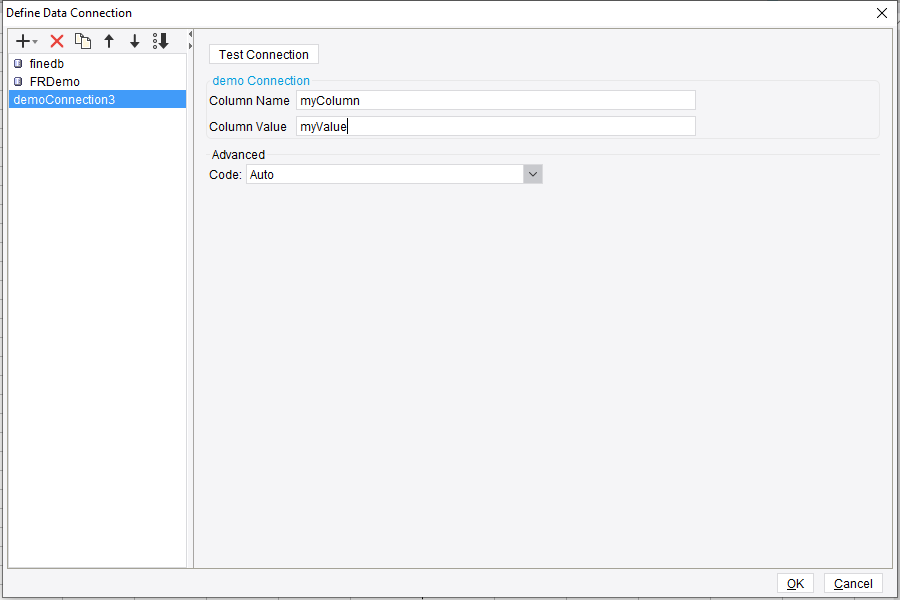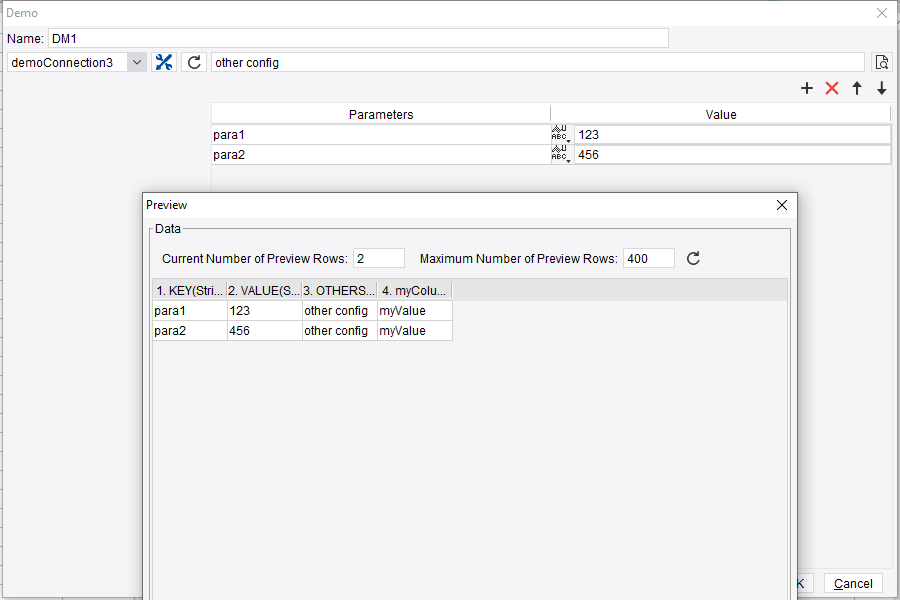Advanced Tutorial - Data Connection
Introduction
This chapter will talk about data connection providers in FineReport. We know that the default types of connection are JDBC and JNDI. We can use this provider to add a new connection.
Since a data connection is tightly bound with the data set, we will use the example in Beginner Tutorial - Dataset and add the data connection part to it.
ConnectionProvider
package com.fr.design.fun;
import com.fr.data.impl.Connection;
import com.fr.design.beans.BasicBeanPane;
import com.fr.stable.fun.mark.Mutable;
public interface ConnectionProvider extends Mutable {
String XML_TAG = "ConnectionProvider";
int CURRENT_LEVEL = 2;
/**
* the name of the popup title
*
* @return name
*/
String nameForConnection();
/**
* the icon of the data connection
*
* @return icon path
*/
String iconPathForConnection();
/**
* the class of the connection
*
* @return connection class
*/
Class<? extends com.fr.data.impl.Connection> classForConnection();
/**
* the pane of the connection
*
* @return connection pane
*/
Class<? extends BasicBeanPane<? extends Connection>> appearanceForConnection();
}
The classForConnection() and appearanceForConnection() introduce two new class: Connection and BasicBeanPane<? extends Connection>. We must implement these two before creating a new data conection.
Connection
This interface represents an actual data connection. Usually, we do not directly implement this interface but extend AbstractDatabaseConnection. Below is an example.
public class DemoConnection extends AbstractDatabaseConnection {
private Conf<String> globalColName = Holders.simple(StringUtils.EMPTY);
private Conf<String> globalColValue = Holders.simple(StringUtils.EMPTY);
/**
* To test the connection. Throw exception if it fails.
* @throws Exception
*/
@Override
public void testConnection() throws Exception {
if(StringUtils.isBlank(this.getGlobalColName())){
throw new Exception();
}
}
/**
* Return the driver of a connection. No need here.
* @return
*/
@Override
public String getDriver() {
return null;
}
public String getGlobalColName() {
return globalColName.get();
}
public void setGlobalColName(String globalColName) {
this.globalColName.set(globalColName);
}
public String getGlobalColValue() {
return globalColValue.get();
}
public void setGlobalColValue(String globalColValue) {
this.globalColValue.set(globalColValue);
}
@Override
public void readXML(XMLableReader reader) {
super.readXML(reader);
if(reader.isChildNode()){
String tagName=reader.getTagName();
if(ComparatorUtils.equals("Attr",tagName)){
this.setGlobalColName(reader.getAttrAsString("colName",StringUtils.EMPTY));
this.setGlobalColValue(reader.getAttrAsString("colValue",StringUtils.EMPTY));
}
}
}
@Override
public void writeXML(XMLPrintWriter writer) {
super.writeXML(writer);
writer.startTAG("Attr").attr("colName",this.getGlobalColName()).attr("colValue",this.getGlobalColValue()).end();
}
}
BasicBeanPane
This is just an implemented JPanel wrapper. The things we need to do are:
- Initialize the pane and add components.
- Reload the current pane according to a connection instance.
- Get a connection instance based on the input on the pane.
- Provide the title of the pane.
FineReport provides a DataConnectionPane which has a defined "Test Connection" button and a "Charset" combo box. We can create our connection pane by inheriting DataConnectionPane.
public class DemoConnectionPane extends DatabaseConnectionPane<DemoConnection> {
// define a text field for column name
private UITextField colName;
// for column value
private UITextField colValue;
private final static double P = TableLayout.PREFERRED;
/**
* Defined in DatabaseConnectionPane. To get the main panel.
* @return
*/
@Override
protected JPanel mainPanel() {
return creatMainPanel();
}
@Override
protected boolean isFineBI() {
return false;
}
/**
* Defined in DatabaseConnectionPane. Reload the setting panel according to the connection object.
* @param demoConnection
*/
@Override
protected void populateSubDatabaseConnectionBean(DemoConnection demoConnection) {
this.colName.setText(demoConnection.getGlobalColName());
this.colValue.setText(demoConnection.getGlobalColValue());
}
/**
* Generate a new connection obj based on the setting panel.
* @return
*/
@Override
protected DemoConnection updateSubDatabaseConnectionBean() {
DemoConnection demoConnection = new DemoConnection();
demoConnection.setGlobalColName(this.colName.getText());
demoConnection.setGlobalColValue(this.colValue.getText());
return demoConnection;
}
/**
* title of the window
* @return
*/
@Override
protected String title4PopupWindow() {
return "demoConnection";
}
/**
* Here add two text fields to the panel.
* @return
*/
public JPanel creatMainPanel() {
colName = new UITextField();
colValue = new UITextField();
Component[][] tables = {{
new UILabel("Column Name"), colName
}, {
new UILabel("Column Value"), colValue
}};
JPanel tableLayoutPane = TableLayoutHelper.createTableLayoutPane(tables, new double[]{P, P}, new double[]{P, 400});
tableLayoutPane.setBorder(UITitledBorder.createBorderWithTitle("demo Connection"));
return tableLayoutPane;
}
}
Register the data connection with the provider.
public class DemoConnectionProvider extends AbstractConnectionProvider {
@Override
public String nameForConnection() {
return "demoConnection";
}
@Override
public String iconPathForConnection() {
return null;
}
@Override
public Class<? extends Connection> classForConnection() {
return DemoConnection.class;
}
@Override
public Class<? extends BasicBeanPane<? extends Connection>> appearanceForConnection() {
return DemoConnectionPane.class;
}
}
Finally, register the provider in plugin.xml.
<extra-designer>
<ConnectionProvider class="com.fr.xxx.xxx.DemoConnectionProvider"/>
</extra-designer>
Example
The effect of this example is this.
You can find the full executable code here: https://github.com/finereport-overseas/report-starter-10/tree/master/plugin-data-source-demo

